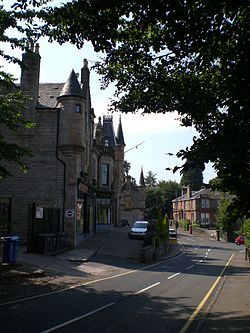| Bridge of Weir | |
|---|---|
 Part of Bridge of Weir's Main Street | |
Location within Renfrewshire | |
| Population | 4,920 (2020) [1] |
| OS grid reference | NS387655 |
| Council area | |
| Lieutenancy area | |
| Country | Scotland |
| Sovereign state | United Kingdom |
| Post town | BRIDGE OF WEIR |
| Postcode district | PA11 |
| Dialling code | 01505 |
| Police | Scotland |
| Fire | Scottish |
| Ambulance | Scottish |
| UK Parliament | |
| Scottish Parliament | |
Bridge of Weir is a village within the Renfrewshire council area and wider historic county of Renfrewshire in the west central Lowlands of Scotland.
Contents
- History
- Toponymy
- Early history
- Later expansion
- Economy
- Leather
- Governance
- Culture and community
- Recreation
- Notable people
- See also
- References
- External links
Lying within the Gryffe Valley, Bridge of Weir owes its name to the historic crossing point that it provided over the River Gryffe. The village was initially formed around industries such as cotton and leather, reliant on the power of the river. These industries brought about its expansion in the 18th century in land attached to the 15th century Ranfurly Castle situated between the two established parishes of Kilbarchan and Houston and Killellan. A rail connection, as part of the Glasgow and South Western Railway, in the 1860s, significantly supported the village's development.
Today Bridge of Weir serves largely as a dormitory settlement for nearby Glasgow and Paisley, maintaining a commercial centre of its own and some light industry and agriculture. It remains well known for its leather production, which has continued since the first industry emerged.



